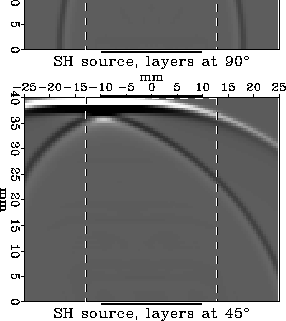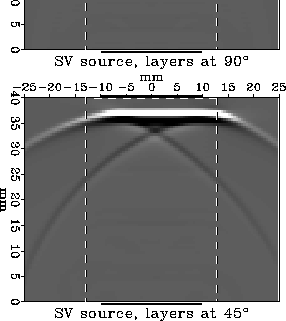




Next: DISCUSSION
Up: MODEL RESULTS
Previous: P waves
What about S waves?
For transversely isotropic (TI) media, there are two
kinds of S waves, SH and qSV.
The SH wavefronts in TI media should be exactly elliptical,
although the amount of elliptical anisotropy can be large.
Other than this slight simplification
(P-wave wavefronts aren't normally elliptical in TI media,
but they probably aren't too weird in ordinary rocks either)
measuring SH traveltimes should theoretically be very
similar to the case for P waves already discussed.
In practice, S-wave transducers are usually twice as large as
P-wave transducers in any given experiment, so it is even more
likely that a good first break corresponding to an accurate
phase velocity will be measured.
Figure ![[*]](http://sepwww.stanford.edu/latex2html/cross_ref_motif.gif) shows how this works in our numerical simulation of
Vernik and Nur's experiment;
although the ``sideways drift'' of the wavefront in the
shows how this works in our numerical simulation of
Vernik and Nur's experiment;
although the ``sideways drift'' of the wavefront in the  SH case is nearly the same as for the
SH case is nearly the same as for the  qP case in Figure
qP case in Figure ![[*]](http://sepwww.stanford.edu/latex2html/cross_ref_motif.gif) ,
the receiver transducer solidly encounters the all-important
``flat'' part of the wavefront instead of merely being grazed by it.
,
the receiver transducer solidly encounters the all-important
``flat'' part of the wavefront instead of merely being grazed by it.
SHexam
Figure 6
Snapshots showing the behavior of SH waves in our
 (top) and
(top) and  (bottom) core-sample simulations.
(The top plot shows the situation at 15.
(bottom) core-sample simulations.
(The top plot shows the situation at 15. s, the bottom at 17.5
s, the bottom at 17.5 s.)
The SH wave in the
s.)
The SH wave in the  case
slips to the left about the same amount that the qP
wave did in Figure
case
slips to the left about the same amount that the qP
wave did in Figure ![[*]](http://sepwww.stanford.edu/latex2html/cross_ref_motif.gif) , but the transducers are twice
as wide so the wavefront hits the receiver anyway.
, but the transducers are twice
as wide so the wavefront hits the receiver anyway.

SVexam
Figure 7
Snapshots showing the behavior of qSV waves in our
 (top) and
(top) and  (bottom) core-sample simulations.
(Both snapshots show the situation at 17.5
(bottom) core-sample simulations.
(Both snapshots show the situation at 17.5 s.)
It so happens that for this wavetype
the
s.)
It so happens that for this wavetype
the  phase direction and its associated group direction are
nearly the same,
so the wavefront in the
phase direction and its associated group direction are
nearly the same,
so the wavefront in the  case (lower plot) does not
significantly crab sideways.
case (lower plot) does not
significantly crab sideways.

The case for qSV waves is trickier. In TI media these waves
can be highly anisotropic and non-elliptical (for example see
Figure ![[*]](http://sepwww.stanford.edu/latex2html/cross_ref_motif.gif) ). On the minus side this means that ``esoteric'' anisotropic
effects such as wavefront cusps could complicate picking the ``first break''.
Cusps are always associated with precursive energy leading
the main qSV arrival (theoretically anchoring it all the way back
to the tail of the already-arrived qP wavefront).
They are point-source, not plane-source
phenomena, so in the worst case they might occur in experiments
such as ours at the edges of the ``flat part'' of the wavefront.
If qSV cusps prove to be problem in an experiment,
it should be possible to lessen the confusion by making
the transducers wider.
On the plus side qSV wavefronts almost always have a near-symmetry
about
). On the minus side this means that ``esoteric'' anisotropic
effects such as wavefront cusps could complicate picking the ``first break''.
Cusps are always associated with precursive energy leading
the main qSV arrival (theoretically anchoring it all the way back
to the tail of the already-arrived qP wavefront).
They are point-source, not plane-source
phenomena, so in the worst case they might occur in experiments
such as ours at the edges of the ``flat part'' of the wavefront.
If qSV cusps prove to be problem in an experiment,
it should be possible to lessen the confusion by making
the transducers wider.
On the plus side qSV wavefronts almost always have a near-symmetry
about  , so the amount of ``side slip'' for
, so the amount of ``side slip'' for  cores
should be small. Figure
cores
should be small. Figure ![[*]](http://sepwww.stanford.edu/latex2html/cross_ref_motif.gif) demonstrates that the qSV waves in our
numerical simulation are indeed the best-behaved of the lot.
The sideways drift is only 3mm to the right, insignificant compared
to the size of the S transducers. (Note the other two wavetypes drifted
to the left.) Furthermore, the qSV wave was not preceded by a
significant amount of precursive energy, so there should have been
no special trouble picking the first break off the recorded signal.
demonstrates that the qSV waves in our
numerical simulation are indeed the best-behaved of the lot.
The sideways drift is only 3mm to the right, insignificant compared
to the size of the S transducers. (Note the other two wavetypes drifted
to the left.) Furthermore, the qSV wave was not preceded by a
significant amount of precursive energy, so there should have been
no special trouble picking the first break off the recorded signal.
It is somewhat ironic that qSV waves (normally thought of as the
most complex of TI wavetypes) appear to be the most well-behaved here,
while ``mild-mannered'' qP waves are the likeliest to be mismeasured.





Next: DISCUSSION
Up: MODEL RESULTS
Previous: P waves
Stanford Exploration Project
12/18/1997
![[*]](http://sepwww.stanford.edu/latex2html/cross_ref_motif.gif) shows how this works in our numerical simulation of
Vernik and Nur's experiment;
although the ``sideways drift'' of the wavefront in the
shows how this works in our numerical simulation of
Vernik and Nur's experiment;
although the ``sideways drift'' of the wavefront in the ![[*]](http://sepwww.stanford.edu/latex2html/cross_ref_motif.gif) ,
the receiver transducer solidly encounters the all-important
``flat'' part of the wavefront instead of merely being grazed by it.
,
the receiver transducer solidly encounters the all-important
``flat'' part of the wavefront instead of merely being grazed by it.

